Business Economics Report: UK Economy, Tesco, and Market Analysis
VerifiedAdded on 2020/07/22
|15
|3735
|338
Report
AI Summary
This report examines the business economics of the UK economy, with a specific focus on the retail giant, Tesco. It delves into critical aspects such as resource allocation, scarcity, and the significance of demand and supply in achieving market equilibrium. The report analyzes various market systems, including monopoly, perfect competition, and oligopolistic markets, and their influence on Tesco's pricing strategies and internal decision-making processes. It further explores the elasticity of demand and its implications for pricing. The analysis extends to the impact of corporate goals on pricing, alongside an examination of relevant UK regulations affecting Tesco's market power. Furthermore, the report addresses changes in the UK economy during the 21st century, their effects on Tesco, and the available macroeconomic tools. It also assesses the UK's economic performance in the international market, concluding with a discussion on comparative advantage and the advantages and disadvantages of free trade, while considering the influence of emerging economies on developed countries. This comprehensive study provides valuable insights into the interplay of business economics and the dynamics of a major UK corporation within a fluctuating economic environment.
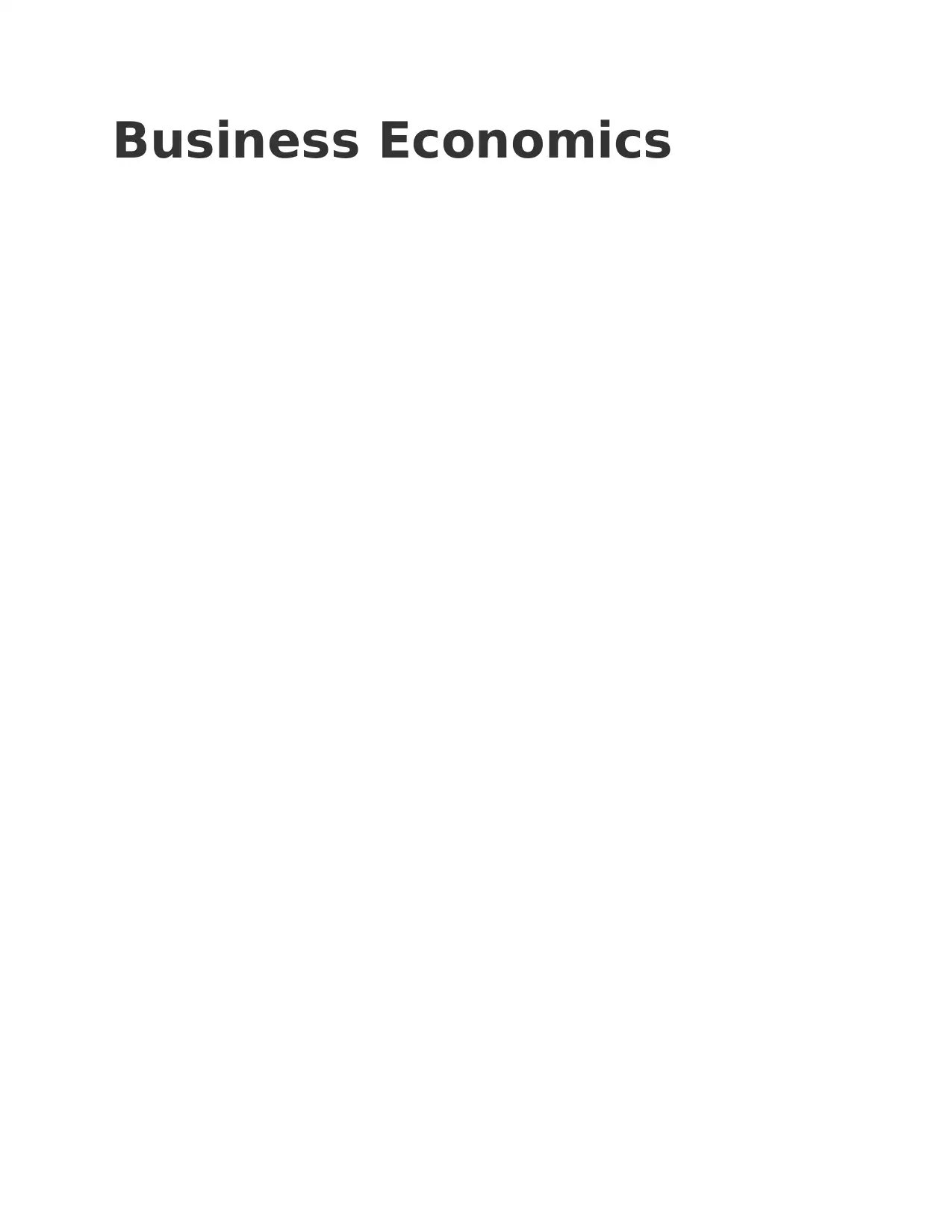
Business Economics
Paraphrase This Document
Need a fresh take? Get an instant paraphrase of this document with our AI Paraphraser

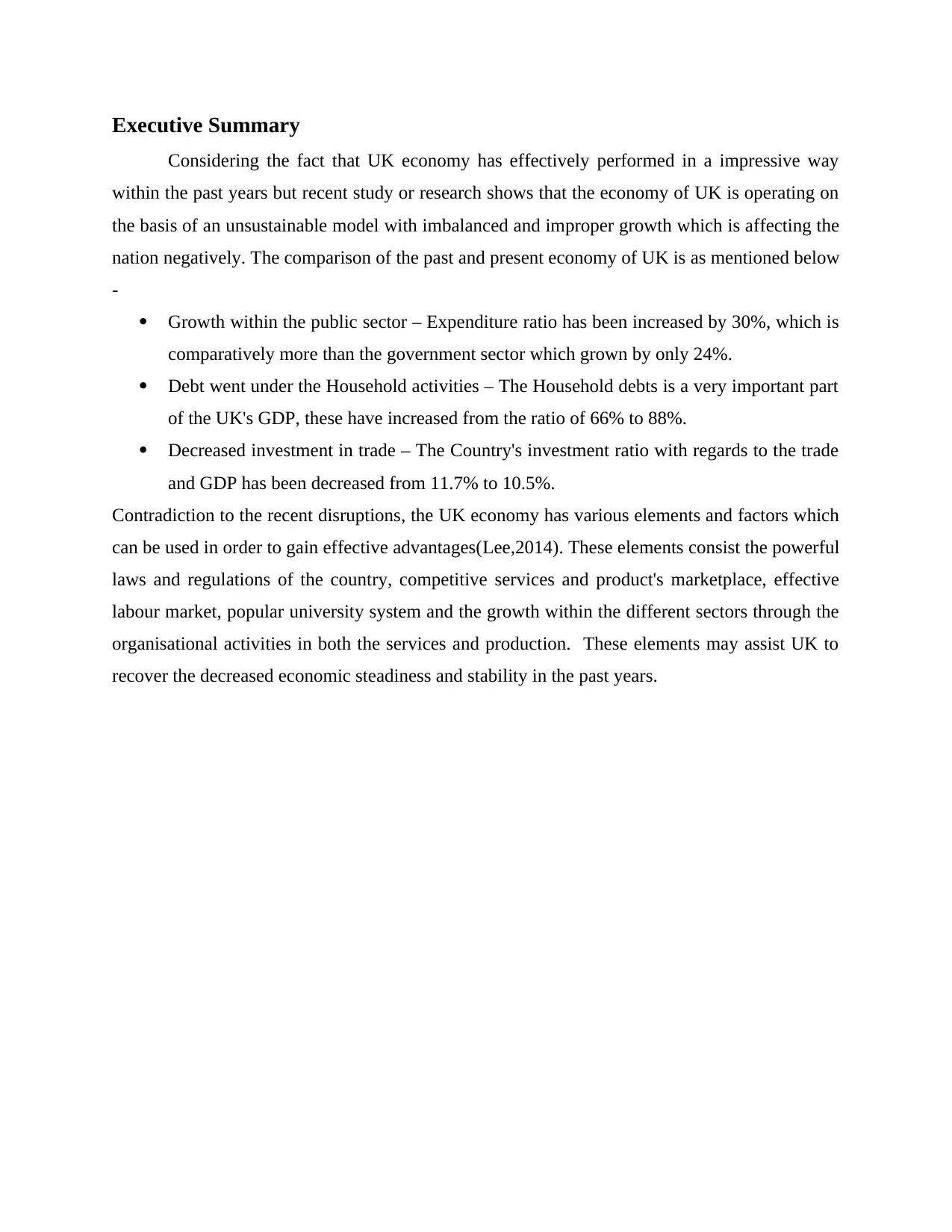
Executive Summary
Considering the fact that UK economy has effectively performed in a impressive way
within the past years but recent study or research shows that the economy of UK is operating on
the basis of an unsustainable model with imbalanced and improper growth which is affecting the
nation negatively. The comparison of the past and present economy of UK is as mentioned below
-
Growth within the public sector – Expenditure ratio has been increased by 30%, which is
comparatively more than the government sector which grown by only 24%.
Debt went under the Household activities – The Household debts is a very important part
of the UK's GDP, these have increased from the ratio of 66% to 88%.
Decreased investment in trade – The Country's investment ratio with regards to the trade
and GDP has been decreased from 11.7% to 10.5%.
Contradiction to the recent disruptions, the UK economy has various elements and factors which
can be used in order to gain effective advantages(Lee,2014). These elements consist the powerful
laws and regulations of the country, competitive services and product's marketplace, effective
labour market, popular university system and the growth within the different sectors through the
organisational activities in both the services and production. These elements may assist UK to
recover the decreased economic steadiness and stability in the past years.
Considering the fact that UK economy has effectively performed in a impressive way
within the past years but recent study or research shows that the economy of UK is operating on
the basis of an unsustainable model with imbalanced and improper growth which is affecting the
nation negatively. The comparison of the past and present economy of UK is as mentioned below
-
Growth within the public sector – Expenditure ratio has been increased by 30%, which is
comparatively more than the government sector which grown by only 24%.
Debt went under the Household activities – The Household debts is a very important part
of the UK's GDP, these have increased from the ratio of 66% to 88%.
Decreased investment in trade – The Country's investment ratio with regards to the trade
and GDP has been decreased from 11.7% to 10.5%.
Contradiction to the recent disruptions, the UK economy has various elements and factors which
can be used in order to gain effective advantages(Lee,2014). These elements consist the powerful
laws and regulations of the country, competitive services and product's marketplace, effective
labour market, popular university system and the growth within the different sectors through the
organisational activities in both the services and production. These elements may assist UK to
recover the decreased economic steadiness and stability in the past years.
⊘ This is a preview!⊘
Do you want full access?
Subscribe today to unlock all pages.

Trusted by 1+ million students worldwide
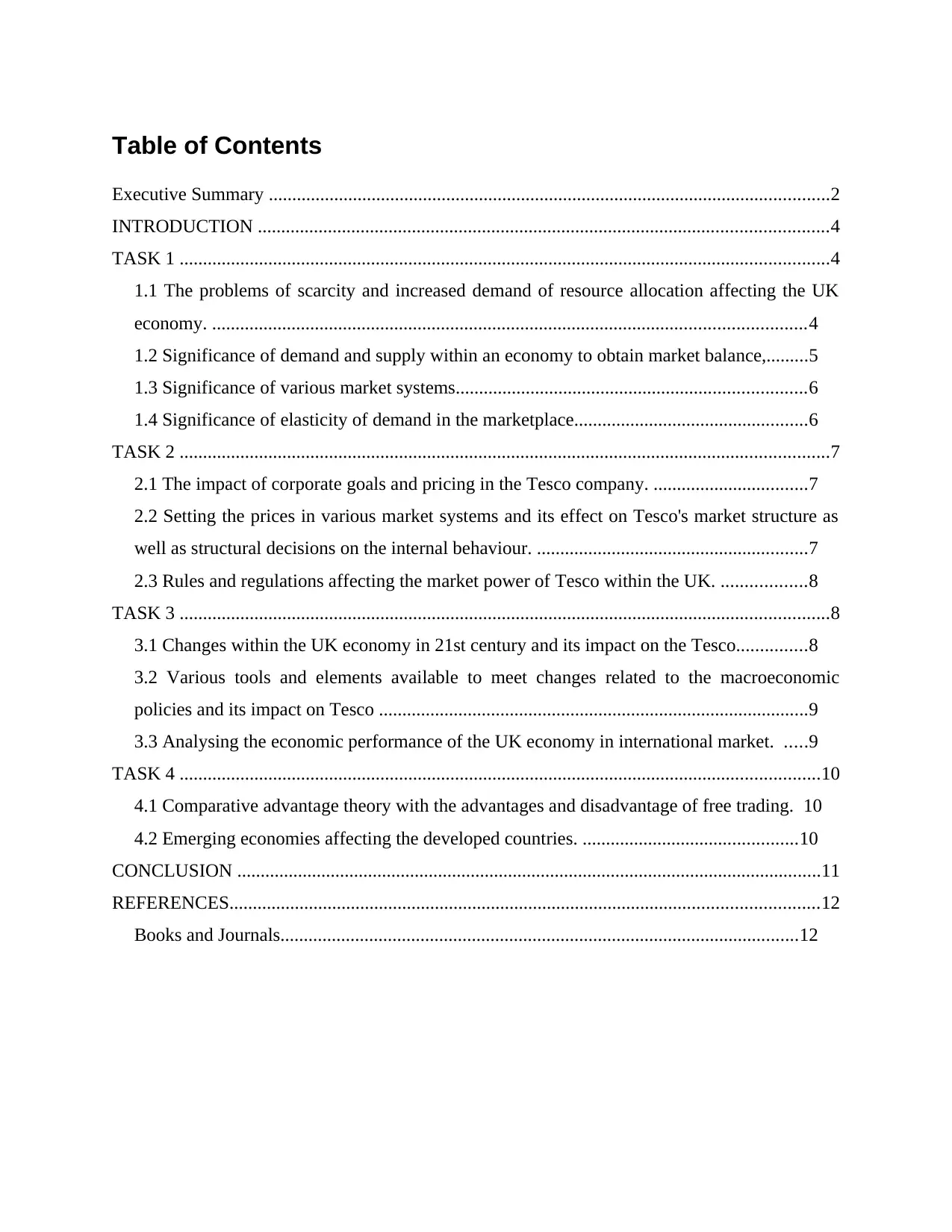
Table of Contents
Executive Summary ........................................................................................................................2
INTRODUCTION ..........................................................................................................................4
TASK 1 ...........................................................................................................................................4
1.1 The problems of scarcity and increased demand of resource allocation affecting the UK
economy. ...............................................................................................................................4
1.2 Significance of demand and supply within an economy to obtain market balance,.........5
1.3 Significance of various market systems...........................................................................6
1.4 Significance of elasticity of demand in the marketplace..................................................6
TASK 2 ...........................................................................................................................................7
2.1 The impact of corporate goals and pricing in the Tesco company. .................................7
2.2 Setting the prices in various market systems and its effect on Tesco's market structure as
well as structural decisions on the internal behaviour. ..........................................................7
2.3 Rules and regulations affecting the market power of Tesco within the UK. ..................8
TASK 3 ...........................................................................................................................................8
3.1 Changes within the UK economy in 21st century and its impact on the Tesco...............8
3.2 Various tools and elements available to meet changes related to the macroeconomic
policies and its impact on Tesco ............................................................................................9
3.3 Analysing the economic performance of the UK economy in international market. .....9
TASK 4 .........................................................................................................................................10
4.1 Comparative advantage theory with the advantages and disadvantage of free trading. 10
4.2 Emerging economies affecting the developed countries. ..............................................10
CONCLUSION .............................................................................................................................11
REFERENCES..............................................................................................................................12
Books and Journals...............................................................................................................12
Executive Summary ........................................................................................................................2
INTRODUCTION ..........................................................................................................................4
TASK 1 ...........................................................................................................................................4
1.1 The problems of scarcity and increased demand of resource allocation affecting the UK
economy. ...............................................................................................................................4
1.2 Significance of demand and supply within an economy to obtain market balance,.........5
1.3 Significance of various market systems...........................................................................6
1.4 Significance of elasticity of demand in the marketplace..................................................6
TASK 2 ...........................................................................................................................................7
2.1 The impact of corporate goals and pricing in the Tesco company. .................................7
2.2 Setting the prices in various market systems and its effect on Tesco's market structure as
well as structural decisions on the internal behaviour. ..........................................................7
2.3 Rules and regulations affecting the market power of Tesco within the UK. ..................8
TASK 3 ...........................................................................................................................................8
3.1 Changes within the UK economy in 21st century and its impact on the Tesco...............8
3.2 Various tools and elements available to meet changes related to the macroeconomic
policies and its impact on Tesco ............................................................................................9
3.3 Analysing the economic performance of the UK economy in international market. .....9
TASK 4 .........................................................................................................................................10
4.1 Comparative advantage theory with the advantages and disadvantage of free trading. 10
4.2 Emerging economies affecting the developed countries. ..............................................10
CONCLUSION .............................................................................................................................11
REFERENCES..............................................................................................................................12
Books and Journals...............................................................................................................12
Paraphrase This Document
Need a fresh take? Get an instant paraphrase of this document with our AI Paraphraser
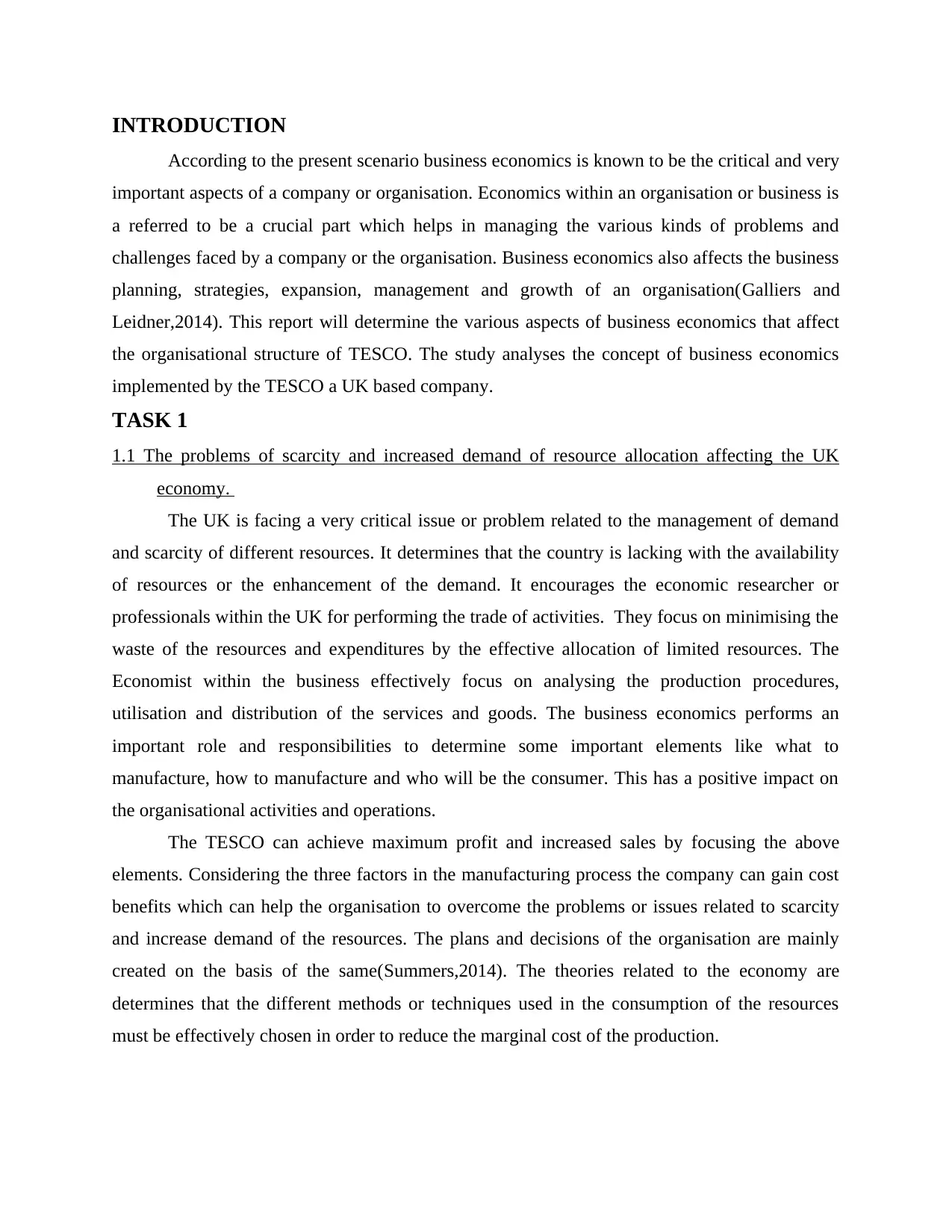
INTRODUCTION
According to the present scenario business economics is known to be the critical and very
important aspects of a company or organisation. Economics within an organisation or business is
a referred to be a crucial part which helps in managing the various kinds of problems and
challenges faced by a company or the organisation. Business economics also affects the business
planning, strategies, expansion, management and growth of an organisation(Galliers and
Leidner,2014). This report will determine the various aspects of business economics that affect
the organisational structure of TESCO. The study analyses the concept of business economics
implemented by the TESCO a UK based company.
TASK 1
1.1 The problems of scarcity and increased demand of resource allocation affecting the UK
economy.
The UK is facing a very critical issue or problem related to the management of demand
and scarcity of different resources. It determines that the country is lacking with the availability
of resources or the enhancement of the demand. It encourages the economic researcher or
professionals within the UK for performing the trade of activities. They focus on minimising the
waste of the resources and expenditures by the effective allocation of limited resources. The
Economist within the business effectively focus on analysing the production procedures,
utilisation and distribution of the services and goods. The business economics performs an
important role and responsibilities to determine some important elements like what to
manufacture, how to manufacture and who will be the consumer. This has a positive impact on
the organisational activities and operations.
The TESCO can achieve maximum profit and increased sales by focusing the above
elements. Considering the three factors in the manufacturing process the company can gain cost
benefits which can help the organisation to overcome the problems or issues related to scarcity
and increase demand of the resources. The plans and decisions of the organisation are mainly
created on the basis of the same(Summers,2014). The theories related to the economy are
determines that the different methods or techniques used in the consumption of the resources
must be effectively chosen in order to reduce the marginal cost of the production.
According to the present scenario business economics is known to be the critical and very
important aspects of a company or organisation. Economics within an organisation or business is
a referred to be a crucial part which helps in managing the various kinds of problems and
challenges faced by a company or the organisation. Business economics also affects the business
planning, strategies, expansion, management and growth of an organisation(Galliers and
Leidner,2014). This report will determine the various aspects of business economics that affect
the organisational structure of TESCO. The study analyses the concept of business economics
implemented by the TESCO a UK based company.
TASK 1
1.1 The problems of scarcity and increased demand of resource allocation affecting the UK
economy.
The UK is facing a very critical issue or problem related to the management of demand
and scarcity of different resources. It determines that the country is lacking with the availability
of resources or the enhancement of the demand. It encourages the economic researcher or
professionals within the UK for performing the trade of activities. They focus on minimising the
waste of the resources and expenditures by the effective allocation of limited resources. The
Economist within the business effectively focus on analysing the production procedures,
utilisation and distribution of the services and goods. The business economics performs an
important role and responsibilities to determine some important elements like what to
manufacture, how to manufacture and who will be the consumer. This has a positive impact on
the organisational activities and operations.
The TESCO can achieve maximum profit and increased sales by focusing the above
elements. Considering the three factors in the manufacturing process the company can gain cost
benefits which can help the organisation to overcome the problems or issues related to scarcity
and increase demand of the resources. The plans and decisions of the organisation are mainly
created on the basis of the same(Summers,2014). The theories related to the economy are
determines that the different methods or techniques used in the consumption of the resources
must be effectively chosen in order to reduce the marginal cost of the production.
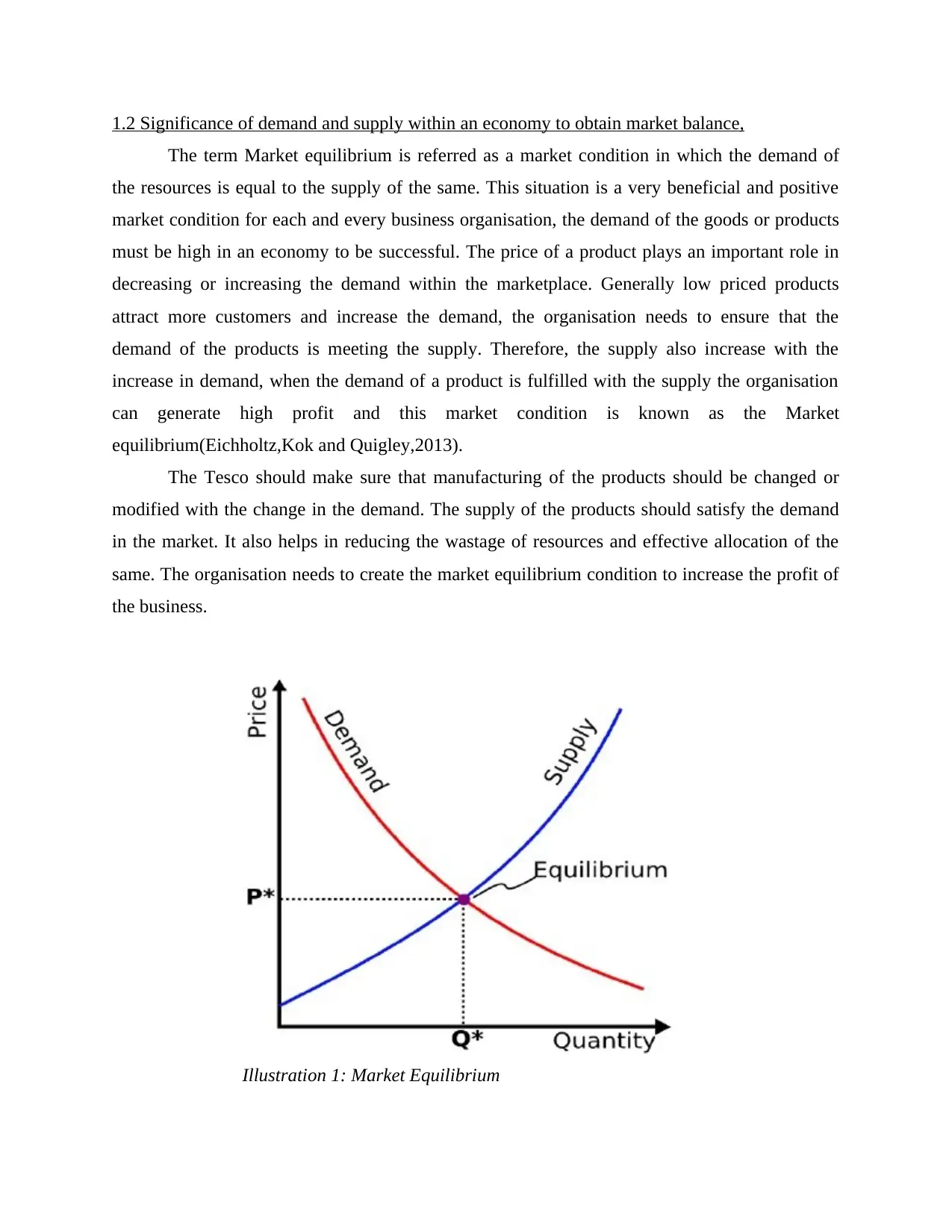
1.2 Significance of demand and supply within an economy to obtain market balance,
The term Market equilibrium is referred as a market condition in which the demand of
the resources is equal to the supply of the same. This situation is a very beneficial and positive
market condition for each and every business organisation, the demand of the goods or products
must be high in an economy to be successful. The price of a product plays an important role in
decreasing or increasing the demand within the marketplace. Generally low priced products
attract more customers and increase the demand, the organisation needs to ensure that the
demand of the products is meeting the supply. Therefore, the supply also increase with the
increase in demand, when the demand of a product is fulfilled with the supply the organisation
can generate high profit and this market condition is known as the Market
equilibrium(Eichholtz,Kok and Quigley,2013).
The Tesco should make sure that manufacturing of the products should be changed or
modified with the change in the demand. The supply of the products should satisfy the demand
in the market. It also helps in reducing the wastage of resources and effective allocation of the
same. The organisation needs to create the market equilibrium condition to increase the profit of
the business.
Illustration 1: Market Equilibrium
The term Market equilibrium is referred as a market condition in which the demand of
the resources is equal to the supply of the same. This situation is a very beneficial and positive
market condition for each and every business organisation, the demand of the goods or products
must be high in an economy to be successful. The price of a product plays an important role in
decreasing or increasing the demand within the marketplace. Generally low priced products
attract more customers and increase the demand, the organisation needs to ensure that the
demand of the products is meeting the supply. Therefore, the supply also increase with the
increase in demand, when the demand of a product is fulfilled with the supply the organisation
can generate high profit and this market condition is known as the Market
equilibrium(Eichholtz,Kok and Quigley,2013).
The Tesco should make sure that manufacturing of the products should be changed or
modified with the change in the demand. The supply of the products should satisfy the demand
in the market. It also helps in reducing the wastage of resources and effective allocation of the
same. The organisation needs to create the market equilibrium condition to increase the profit of
the business.
Illustration 1: Market Equilibrium
⊘ This is a preview!⊘
Do you want full access?
Subscribe today to unlock all pages.

Trusted by 1+ million students worldwide
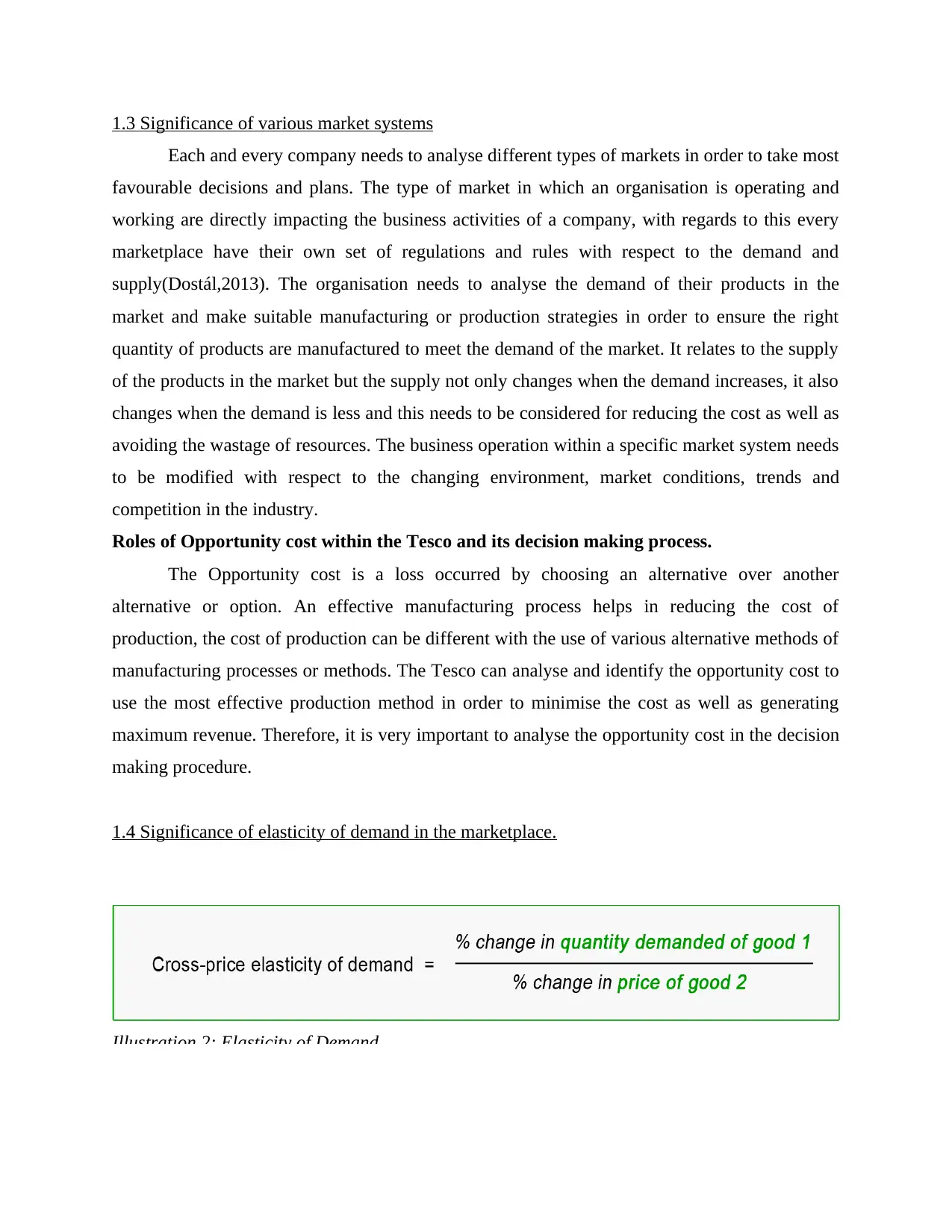
1.3 Significance of various market systems
Each and every company needs to analyse different types of markets in order to take most
favourable decisions and plans. The type of market in which an organisation is operating and
working are directly impacting the business activities of a company, with regards to this every
marketplace have their own set of regulations and rules with respect to the demand and
supply(Dostál,2013). The organisation needs to analyse the demand of their products in the
market and make suitable manufacturing or production strategies in order to ensure the right
quantity of products are manufactured to meet the demand of the market. It relates to the supply
of the products in the market but the supply not only changes when the demand increases, it also
changes when the demand is less and this needs to be considered for reducing the cost as well as
avoiding the wastage of resources. The business operation within a specific market system needs
to be modified with respect to the changing environment, market conditions, trends and
competition in the industry.
Roles of Opportunity cost within the Tesco and its decision making process.
The Opportunity cost is a loss occurred by choosing an alternative over another
alternative or option. An effective manufacturing process helps in reducing the cost of
production, the cost of production can be different with the use of various alternative methods of
manufacturing processes or methods. The Tesco can analyse and identify the opportunity cost to
use the most effective production method in order to minimise the cost as well as generating
maximum revenue. Therefore, it is very important to analyse the opportunity cost in the decision
making procedure.
1.4 Significance of elasticity of demand in the marketplace.
Illustration 2: Elasticity of Demand
Each and every company needs to analyse different types of markets in order to take most
favourable decisions and plans. The type of market in which an organisation is operating and
working are directly impacting the business activities of a company, with regards to this every
marketplace have their own set of regulations and rules with respect to the demand and
supply(Dostál,2013). The organisation needs to analyse the demand of their products in the
market and make suitable manufacturing or production strategies in order to ensure the right
quantity of products are manufactured to meet the demand of the market. It relates to the supply
of the products in the market but the supply not only changes when the demand increases, it also
changes when the demand is less and this needs to be considered for reducing the cost as well as
avoiding the wastage of resources. The business operation within a specific market system needs
to be modified with respect to the changing environment, market conditions, trends and
competition in the industry.
Roles of Opportunity cost within the Tesco and its decision making process.
The Opportunity cost is a loss occurred by choosing an alternative over another
alternative or option. An effective manufacturing process helps in reducing the cost of
production, the cost of production can be different with the use of various alternative methods of
manufacturing processes or methods. The Tesco can analyse and identify the opportunity cost to
use the most effective production method in order to minimise the cost as well as generating
maximum revenue. Therefore, it is very important to analyse the opportunity cost in the decision
making procedure.
1.4 Significance of elasticity of demand in the marketplace.
Illustration 2: Elasticity of Demand
Paraphrase This Document
Need a fresh take? Get an instant paraphrase of this document with our AI Paraphraser
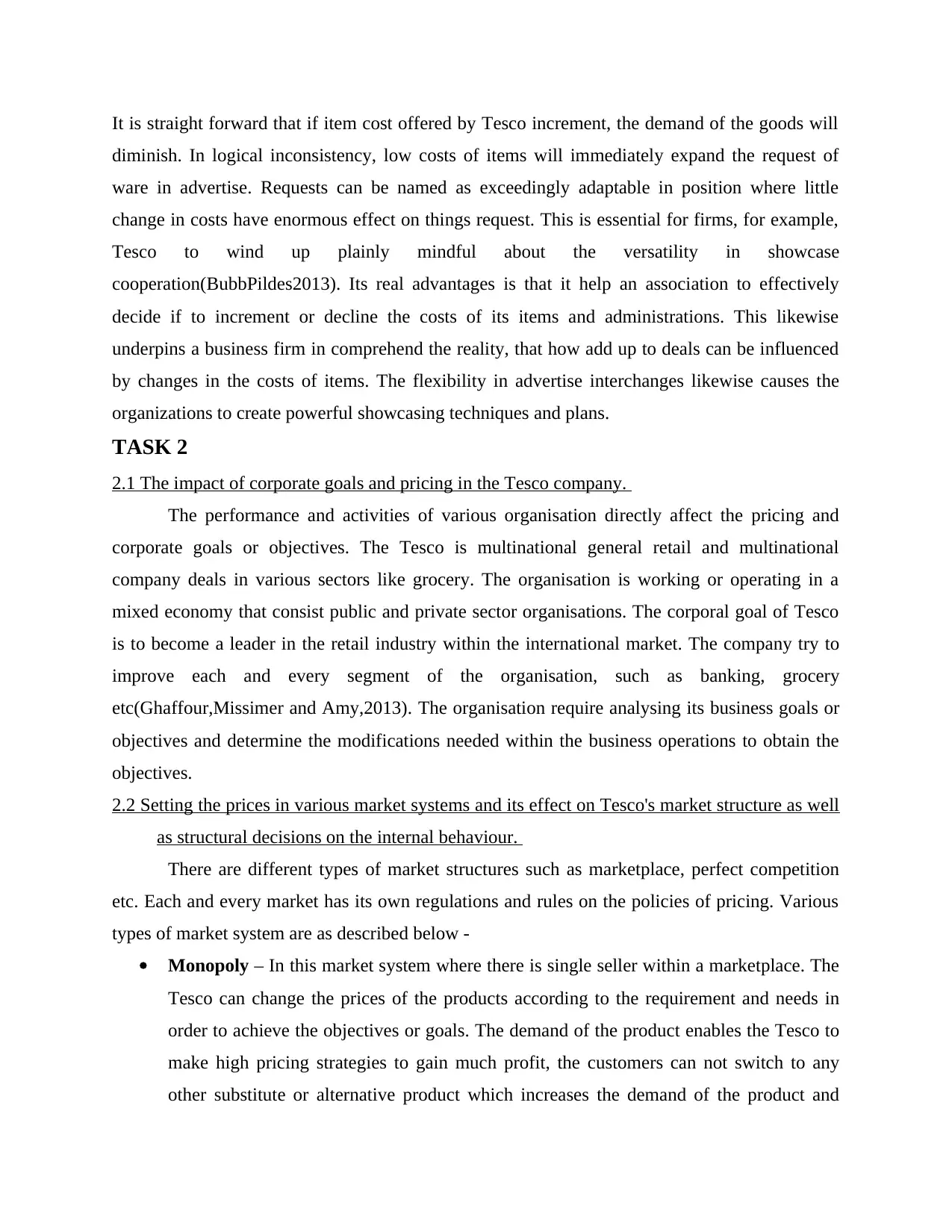
It is straight forward that if item cost offered by Tesco increment, the demand of the goods will
diminish. In logical inconsistency, low costs of items will immediately expand the request of
ware in advertise. Requests can be named as exceedingly adaptable in position where little
change in costs have enormous effect on things request. This is essential for firms, for example,
Tesco to wind up plainly mindful about the versatility in showcase
cooperation(BubbPildes2013). Its real advantages is that it help an association to effectively
decide if to increment or decline the costs of its items and administrations. This likewise
underpins a business firm in comprehend the reality, that how add up to deals can be influenced
by changes in the costs of items. The flexibility in advertise interchanges likewise causes the
organizations to create powerful showcasing techniques and plans.
TASK 2
2.1 The impact of corporate goals and pricing in the Tesco company.
The performance and activities of various organisation directly affect the pricing and
corporate goals or objectives. The Tesco is multinational general retail and multinational
company deals in various sectors like grocery. The organisation is working or operating in a
mixed economy that consist public and private sector organisations. The corporal goal of Tesco
is to become a leader in the retail industry within the international market. The company try to
improve each and every segment of the organisation, such as banking, grocery
etc(Ghaffour,Missimer and Amy,2013). The organisation require analysing its business goals or
objectives and determine the modifications needed within the business operations to obtain the
objectives.
2.2 Setting the prices in various market systems and its effect on Tesco's market structure as well
as structural decisions on the internal behaviour.
There are different types of market structures such as marketplace, perfect competition
etc. Each and every market has its own regulations and rules on the policies of pricing. Various
types of market system are as described below -
Monopoly – In this market system where there is single seller within a marketplace. The
Tesco can change the prices of the products according to the requirement and needs in
order to achieve the objectives or goals. The demand of the product enables the Tesco to
make high pricing strategies to gain much profit, the customers can not switch to any
other substitute or alternative product which increases the demand of the product and
diminish. In logical inconsistency, low costs of items will immediately expand the request of
ware in advertise. Requests can be named as exceedingly adaptable in position where little
change in costs have enormous effect on things request. This is essential for firms, for example,
Tesco to wind up plainly mindful about the versatility in showcase
cooperation(BubbPildes2013). Its real advantages is that it help an association to effectively
decide if to increment or decline the costs of its items and administrations. This likewise
underpins a business firm in comprehend the reality, that how add up to deals can be influenced
by changes in the costs of items. The flexibility in advertise interchanges likewise causes the
organizations to create powerful showcasing techniques and plans.
TASK 2
2.1 The impact of corporate goals and pricing in the Tesco company.
The performance and activities of various organisation directly affect the pricing and
corporate goals or objectives. The Tesco is multinational general retail and multinational
company deals in various sectors like grocery. The organisation is working or operating in a
mixed economy that consist public and private sector organisations. The corporal goal of Tesco
is to become a leader in the retail industry within the international market. The company try to
improve each and every segment of the organisation, such as banking, grocery
etc(Ghaffour,Missimer and Amy,2013). The organisation require analysing its business goals or
objectives and determine the modifications needed within the business operations to obtain the
objectives.
2.2 Setting the prices in various market systems and its effect on Tesco's market structure as well
as structural decisions on the internal behaviour.
There are different types of market structures such as marketplace, perfect competition
etc. Each and every market has its own regulations and rules on the policies of pricing. Various
types of market system are as described below -
Monopoly – In this market system where there is single seller within a marketplace. The
Tesco can change the prices of the products according to the requirement and needs in
order to achieve the objectives or goals. The demand of the product enables the Tesco to
make high pricing strategies to gain much profit, the customers can not switch to any
other substitute or alternative product which increases the demand of the product and
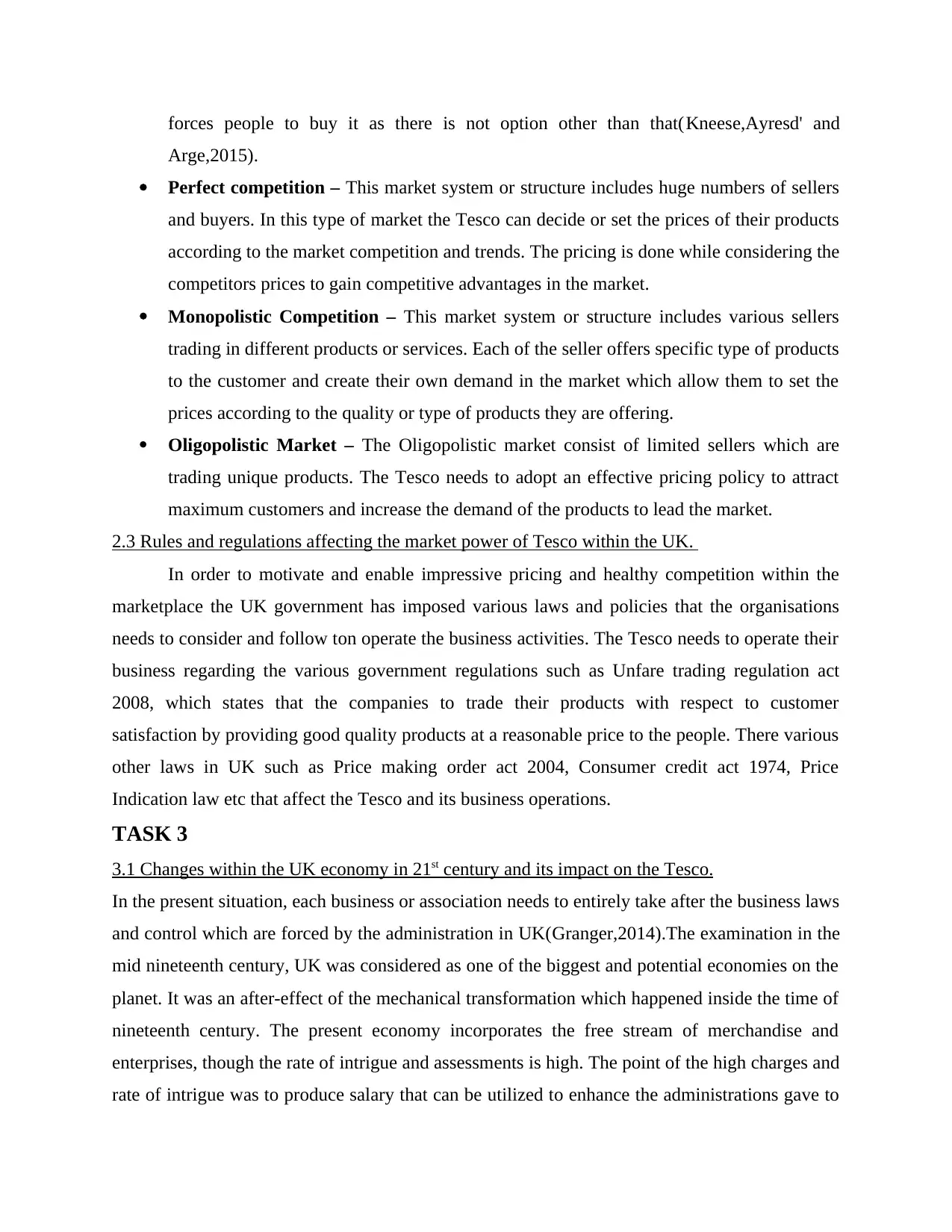
forces people to buy it as there is not option other than that(Kneese,Ayresd' and
Arge,2015).
Perfect competition – This market system or structure includes huge numbers of sellers
and buyers. In this type of market the Tesco can decide or set the prices of their products
according to the market competition and trends. The pricing is done while considering the
competitors prices to gain competitive advantages in the market.
Monopolistic Competition – This market system or structure includes various sellers
trading in different products or services. Each of the seller offers specific type of products
to the customer and create their own demand in the market which allow them to set the
prices according to the quality or type of products they are offering.
Oligopolistic Market – The Oligopolistic market consist of limited sellers which are
trading unique products. The Tesco needs to adopt an effective pricing policy to attract
maximum customers and increase the demand of the products to lead the market.
2.3 Rules and regulations affecting the market power of Tesco within the UK.
In order to motivate and enable impressive pricing and healthy competition within the
marketplace the UK government has imposed various laws and policies that the organisations
needs to consider and follow ton operate the business activities. The Tesco needs to operate their
business regarding the various government regulations such as Unfare trading regulation act
2008, which states that the companies to trade their products with respect to customer
satisfaction by providing good quality products at a reasonable price to the people. There various
other laws in UK such as Price making order act 2004, Consumer credit act 1974, Price
Indication law etc that affect the Tesco and its business operations.
TASK 3
3.1 Changes within the UK economy in 21st century and its impact on the Tesco.
In the present situation, each business or association needs to entirely take after the business laws
and control which are forced by the administration in UK(Granger,2014).The examination in the
mid nineteenth century, UK was considered as one of the biggest and potential economies on the
planet. It was an after-effect of the mechanical transformation which happened inside the time of
nineteenth century. The present economy incorporates the free stream of merchandise and
enterprises, though the rate of intrigue and assessments is high. The point of the high charges and
rate of intrigue was to produce salary that can be utilized to enhance the administrations gave to
Arge,2015).
Perfect competition – This market system or structure includes huge numbers of sellers
and buyers. In this type of market the Tesco can decide or set the prices of their products
according to the market competition and trends. The pricing is done while considering the
competitors prices to gain competitive advantages in the market.
Monopolistic Competition – This market system or structure includes various sellers
trading in different products or services. Each of the seller offers specific type of products
to the customer and create their own demand in the market which allow them to set the
prices according to the quality or type of products they are offering.
Oligopolistic Market – The Oligopolistic market consist of limited sellers which are
trading unique products. The Tesco needs to adopt an effective pricing policy to attract
maximum customers and increase the demand of the products to lead the market.
2.3 Rules and regulations affecting the market power of Tesco within the UK.
In order to motivate and enable impressive pricing and healthy competition within the
marketplace the UK government has imposed various laws and policies that the organisations
needs to consider and follow ton operate the business activities. The Tesco needs to operate their
business regarding the various government regulations such as Unfare trading regulation act
2008, which states that the companies to trade their products with respect to customer
satisfaction by providing good quality products at a reasonable price to the people. There various
other laws in UK such as Price making order act 2004, Consumer credit act 1974, Price
Indication law etc that affect the Tesco and its business operations.
TASK 3
3.1 Changes within the UK economy in 21st century and its impact on the Tesco.
In the present situation, each business or association needs to entirely take after the business laws
and control which are forced by the administration in UK(Granger,2014).The examination in the
mid nineteenth century, UK was considered as one of the biggest and potential economies on the
planet. It was an after-effect of the mechanical transformation which happened inside the time of
nineteenth century. The present economy incorporates the free stream of merchandise and
enterprises, though the rate of intrigue and assessments is high. The point of the high charges and
rate of intrigue was to produce salary that can be utilized to enhance the administrations gave to
⊘ This is a preview!⊘
Do you want full access?
Subscribe today to unlock all pages.

Trusted by 1+ million students worldwide
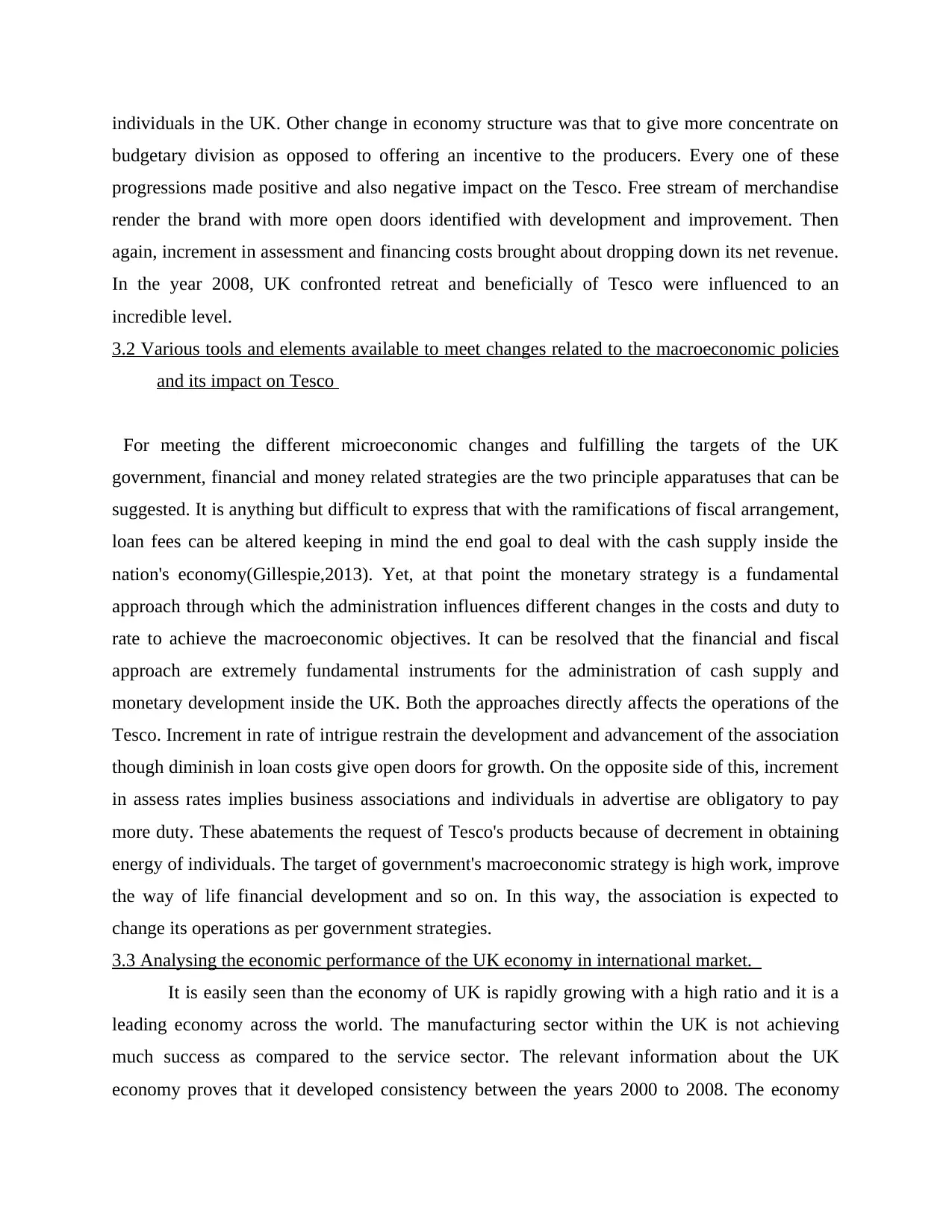
individuals in the UK. Other change in economy structure was that to give more concentrate on
budgetary division as opposed to offering an incentive to the producers. Every one of these
progressions made positive and also negative impact on the Tesco. Free stream of merchandise
render the brand with more open doors identified with development and improvement. Then
again, increment in assessment and financing costs brought about dropping down its net revenue.
In the year 2008, UK confronted retreat and beneficially of Tesco were influenced to an
incredible level.
3.2 Various tools and elements available to meet changes related to the macroeconomic policies
and its impact on Tesco
For meeting the different microeconomic changes and fulfilling the targets of the UK
government, financial and money related strategies are the two principle apparatuses that can be
suggested. It is anything but difficult to express that with the ramifications of fiscal arrangement,
loan fees can be altered keeping in mind the end goal to deal with the cash supply inside the
nation's economy(Gillespie,2013). Yet, at that point the monetary strategy is a fundamental
approach through which the administration influences different changes in the costs and duty to
rate to achieve the macroeconomic objectives. It can be resolved that the financial and fiscal
approach are extremely fundamental instruments for the administration of cash supply and
monetary development inside the UK. Both the approaches directly affects the operations of the
Tesco. Increment in rate of intrigue restrain the development and advancement of the association
though diminish in loan costs give open doors for growth. On the opposite side of this, increment
in assess rates implies business associations and individuals in advertise are obligatory to pay
more duty. These abatements the request of Tesco's products because of decrement in obtaining
energy of individuals. The target of government's macroeconomic strategy is high work, improve
the way of life financial development and so on. In this way, the association is expected to
change its operations as per government strategies.
3.3 Analysing the economic performance of the UK economy in international market.
It is easily seen than the economy of UK is rapidly growing with a high ratio and it is a
leading economy across the world. The manufacturing sector within the UK is not achieving
much success as compared to the service sector. The relevant information about the UK
economy proves that it developed consistency between the years 2000 to 2008. The economy
budgetary division as opposed to offering an incentive to the producers. Every one of these
progressions made positive and also negative impact on the Tesco. Free stream of merchandise
render the brand with more open doors identified with development and improvement. Then
again, increment in assessment and financing costs brought about dropping down its net revenue.
In the year 2008, UK confronted retreat and beneficially of Tesco were influenced to an
incredible level.
3.2 Various tools and elements available to meet changes related to the macroeconomic policies
and its impact on Tesco
For meeting the different microeconomic changes and fulfilling the targets of the UK
government, financial and money related strategies are the two principle apparatuses that can be
suggested. It is anything but difficult to express that with the ramifications of fiscal arrangement,
loan fees can be altered keeping in mind the end goal to deal with the cash supply inside the
nation's economy(Gillespie,2013). Yet, at that point the monetary strategy is a fundamental
approach through which the administration influences different changes in the costs and duty to
rate to achieve the macroeconomic objectives. It can be resolved that the financial and fiscal
approach are extremely fundamental instruments for the administration of cash supply and
monetary development inside the UK. Both the approaches directly affects the operations of the
Tesco. Increment in rate of intrigue restrain the development and advancement of the association
though diminish in loan costs give open doors for growth. On the opposite side of this, increment
in assess rates implies business associations and individuals in advertise are obligatory to pay
more duty. These abatements the request of Tesco's products because of decrement in obtaining
energy of individuals. The target of government's macroeconomic strategy is high work, improve
the way of life financial development and so on. In this way, the association is expected to
change its operations as per government strategies.
3.3 Analysing the economic performance of the UK economy in international market.
It is easily seen than the economy of UK is rapidly growing with a high ratio and it is a
leading economy across the world. The manufacturing sector within the UK is not achieving
much success as compared to the service sector. The relevant information about the UK
economy proves that it developed consistency between the years 2000 to 2008. The economy
Paraphrase This Document
Need a fresh take? Get an instant paraphrase of this document with our AI Paraphraser
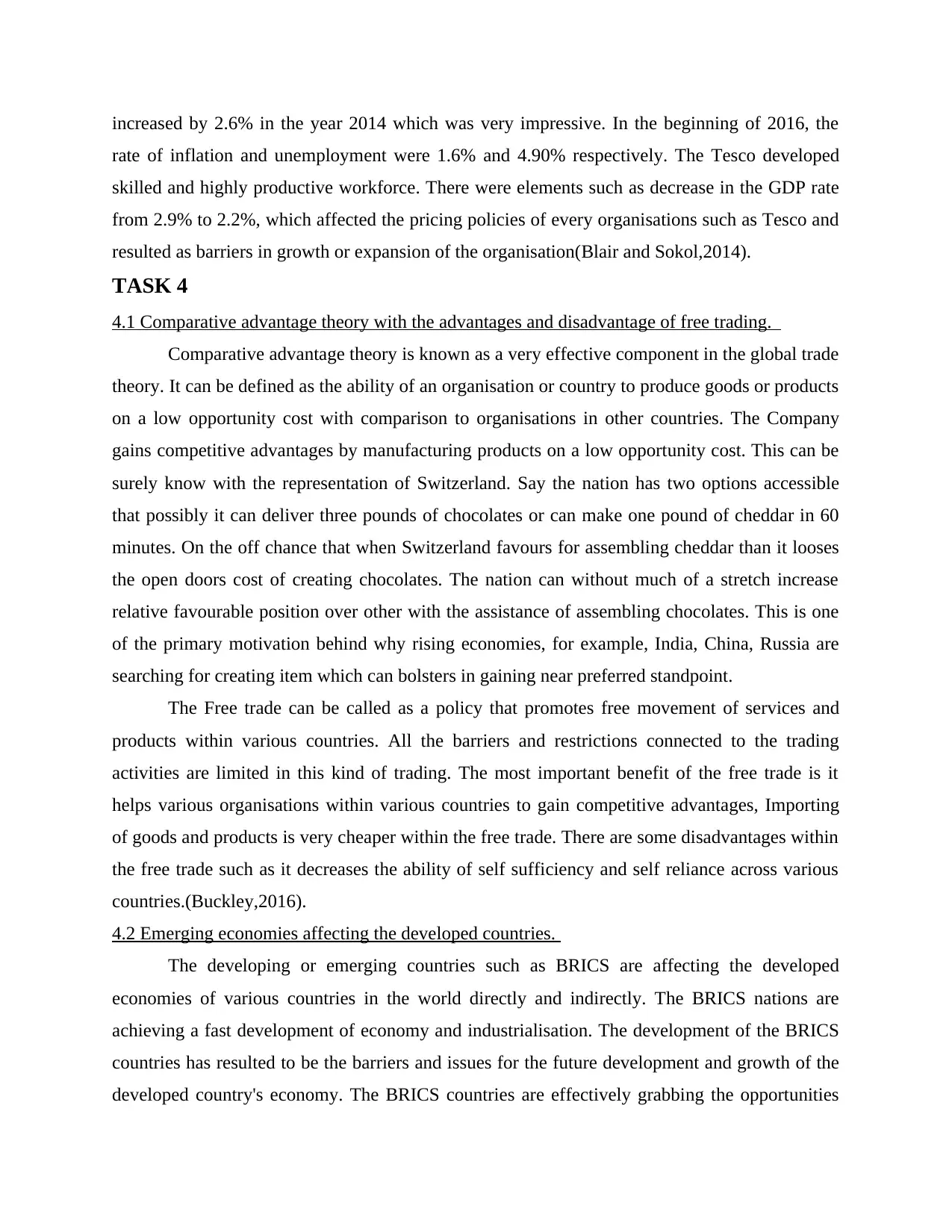
increased by 2.6% in the year 2014 which was very impressive. In the beginning of 2016, the
rate of inflation and unemployment were 1.6% and 4.90% respectively. The Tesco developed
skilled and highly productive workforce. There were elements such as decrease in the GDP rate
from 2.9% to 2.2%, which affected the pricing policies of every organisations such as Tesco and
resulted as barriers in growth or expansion of the organisation(Blair and Sokol,2014).
TASK 4
4.1 Comparative advantage theory with the advantages and disadvantage of free trading.
Comparative advantage theory is known as a very effective component in the global trade
theory. It can be defined as the ability of an organisation or country to produce goods or products
on a low opportunity cost with comparison to organisations in other countries. The Company
gains competitive advantages by manufacturing products on a low opportunity cost. This can be
surely know with the representation of Switzerland. Say the nation has two options accessible
that possibly it can deliver three pounds of chocolates or can make one pound of cheddar in 60
minutes. On the off chance that when Switzerland favours for assembling cheddar than it looses
the open doors cost of creating chocolates. The nation can without much of a stretch increase
relative favourable position over other with the assistance of assembling chocolates. This is one
of the primary motivation behind why rising economies, for example, India, China, Russia are
searching for creating item which can bolsters in gaining near preferred standpoint.
The Free trade can be called as a policy that promotes free movement of services and
products within various countries. All the barriers and restrictions connected to the trading
activities are limited in this kind of trading. The most important benefit of the free trade is it
helps various organisations within various countries to gain competitive advantages, Importing
of goods and products is very cheaper within the free trade. There are some disadvantages within
the free trade such as it decreases the ability of self sufficiency and self reliance across various
countries.(Buckley,2016).
4.2 Emerging economies affecting the developed countries.
The developing or emerging countries such as BRICS are affecting the developed
economies of various countries in the world directly and indirectly. The BRICS nations are
achieving a fast development of economy and industrialisation. The development of the BRICS
countries has resulted to be the barriers and issues for the future development and growth of the
developed country's economy. The BRICS countries are effectively grabbing the opportunities
rate of inflation and unemployment were 1.6% and 4.90% respectively. The Tesco developed
skilled and highly productive workforce. There were elements such as decrease in the GDP rate
from 2.9% to 2.2%, which affected the pricing policies of every organisations such as Tesco and
resulted as barriers in growth or expansion of the organisation(Blair and Sokol,2014).
TASK 4
4.1 Comparative advantage theory with the advantages and disadvantage of free trading.
Comparative advantage theory is known as a very effective component in the global trade
theory. It can be defined as the ability of an organisation or country to produce goods or products
on a low opportunity cost with comparison to organisations in other countries. The Company
gains competitive advantages by manufacturing products on a low opportunity cost. This can be
surely know with the representation of Switzerland. Say the nation has two options accessible
that possibly it can deliver three pounds of chocolates or can make one pound of cheddar in 60
minutes. On the off chance that when Switzerland favours for assembling cheddar than it looses
the open doors cost of creating chocolates. The nation can without much of a stretch increase
relative favourable position over other with the assistance of assembling chocolates. This is one
of the primary motivation behind why rising economies, for example, India, China, Russia are
searching for creating item which can bolsters in gaining near preferred standpoint.
The Free trade can be called as a policy that promotes free movement of services and
products within various countries. All the barriers and restrictions connected to the trading
activities are limited in this kind of trading. The most important benefit of the free trade is it
helps various organisations within various countries to gain competitive advantages, Importing
of goods and products is very cheaper within the free trade. There are some disadvantages within
the free trade such as it decreases the ability of self sufficiency and self reliance across various
countries.(Buckley,2016).
4.2 Emerging economies affecting the developed countries.
The developing or emerging countries such as BRICS are affecting the developed
economies of various countries in the world directly and indirectly. The BRICS nations are
achieving a fast development of economy and industrialisation. The development of the BRICS
countries has resulted to be the barriers and issues for the future development and growth of the
developed country's economy. The BRICS countries are effectively grabbing the opportunities
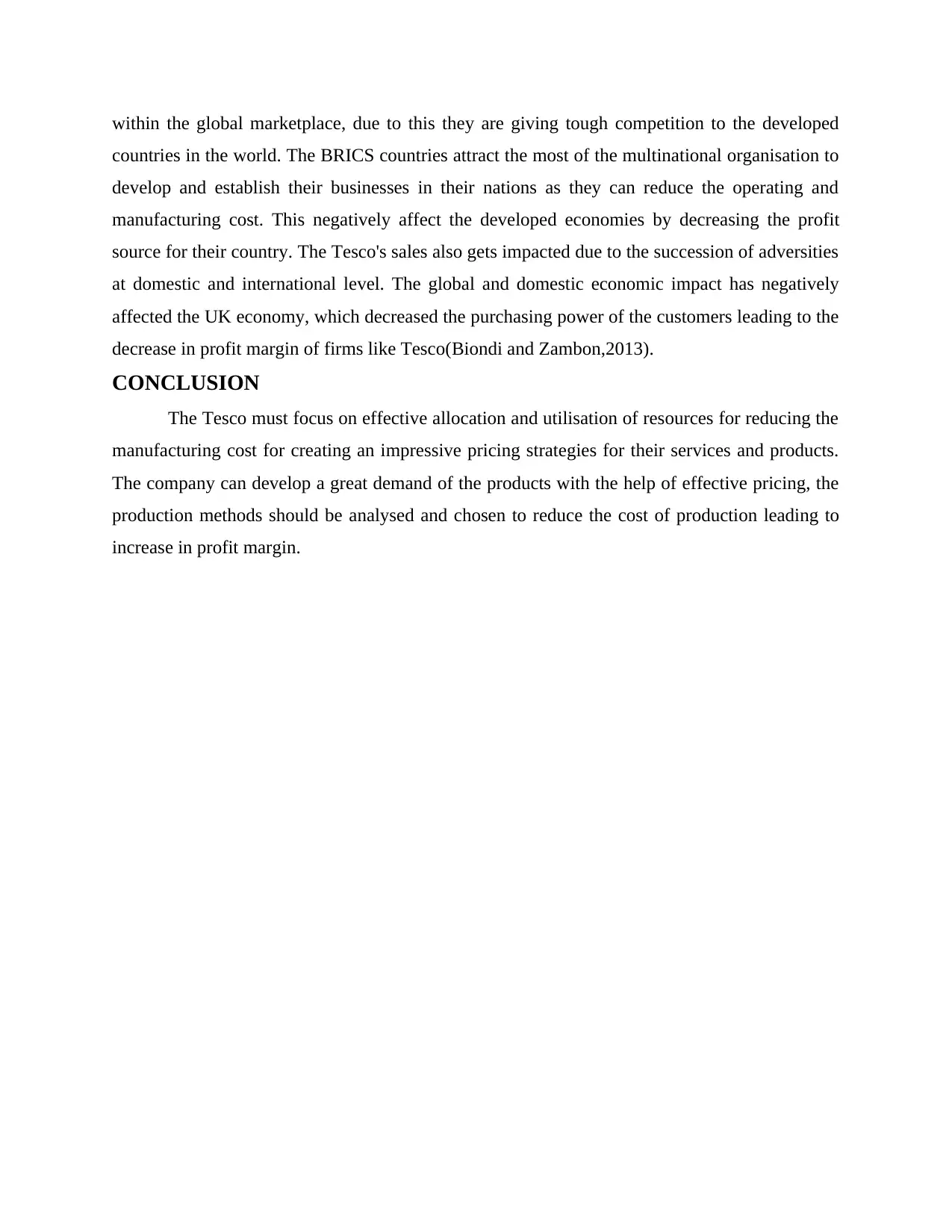
within the global marketplace, due to this they are giving tough competition to the developed
countries in the world. The BRICS countries attract the most of the multinational organisation to
develop and establish their businesses in their nations as they can reduce the operating and
manufacturing cost. This negatively affect the developed economies by decreasing the profit
source for their country. The Tesco's sales also gets impacted due to the succession of adversities
at domestic and international level. The global and domestic economic impact has negatively
affected the UK economy, which decreased the purchasing power of the customers leading to the
decrease in profit margin of firms like Tesco(Biondi and Zambon,2013).
CONCLUSION
The Tesco must focus on effective allocation and utilisation of resources for reducing the
manufacturing cost for creating an impressive pricing strategies for their services and products.
The company can develop a great demand of the products with the help of effective pricing, the
production methods should be analysed and chosen to reduce the cost of production leading to
increase in profit margin.
countries in the world. The BRICS countries attract the most of the multinational organisation to
develop and establish their businesses in their nations as they can reduce the operating and
manufacturing cost. This negatively affect the developed economies by decreasing the profit
source for their country. The Tesco's sales also gets impacted due to the succession of adversities
at domestic and international level. The global and domestic economic impact has negatively
affected the UK economy, which decreased the purchasing power of the customers leading to the
decrease in profit margin of firms like Tesco(Biondi and Zambon,2013).
CONCLUSION
The Tesco must focus on effective allocation and utilisation of resources for reducing the
manufacturing cost for creating an impressive pricing strategies for their services and products.
The company can develop a great demand of the products with the help of effective pricing, the
production methods should be analysed and chosen to reduce the cost of production leading to
increase in profit margin.
⊘ This is a preview!⊘
Do you want full access?
Subscribe today to unlock all pages.

Trusted by 1+ million students worldwide
1 out of 15
Related Documents
Your All-in-One AI-Powered Toolkit for Academic Success.
+13062052269
info@desklib.com
Available 24*7 on WhatsApp / Email
![[object Object]](/_next/static/media/star-bottom.7253800d.svg)
Unlock your academic potential
Copyright © 2020–2025 A2Z Services. All Rights Reserved. Developed and managed by ZUCOL.





